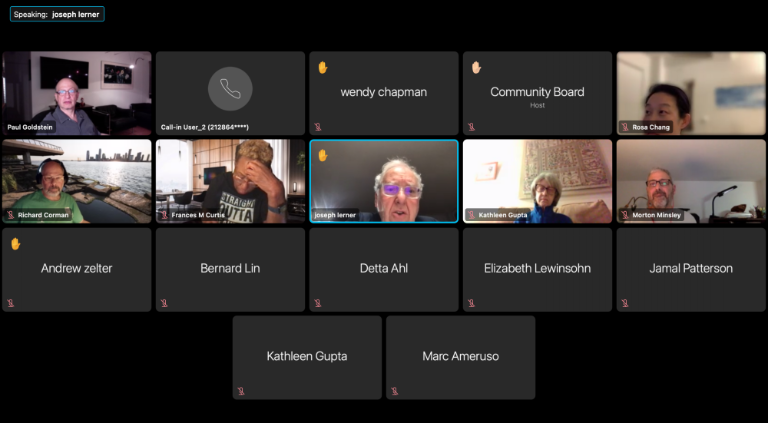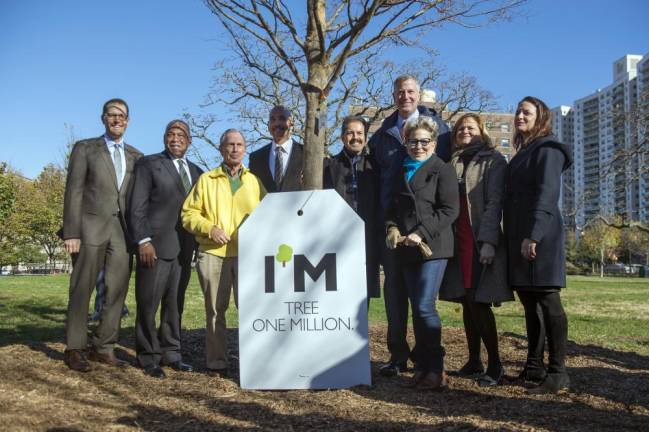The City May Be In For a Million More Trees
Downtown, CB1’s Waterfront, Parks & Cultural Committee discussed how to best support a call from borough presidents for a sequel to the “Million Trees” initiative


It won’t happen overnight, but the city may be destined to grow more green. A sequel to the “Million Trees” initiative, this time under the title “Million More Trees,” will mean more canopy cover and lusher streets by 2030 — if the city follows through on the revamp request made by all five borough presidents at the start of the year.
It’s an undertaking that “all New Yorkers can get behind,” said District Manager Lucian Reynolds on Tuesday night, during an online Community Board 1 meeting.
Members of the board’s Waterfront, Parks & Cultural Committee overwhelmingly expressed their support of the initiative, with specific recommendations. Alternative methods of planting trees and techniques to get neighborhood communities involved were top of mind. “You would have streets that would look very different,” Reynolds said.
Then and Now
Under former Mayor Michael Bloomberg, the original “Million Trees” initiative kicked off in 2007; the goal was to plant one million new trees by 2017. In 2015, then-Mayor Bill de Blasio celebrated the program’s successful completion two years earlier than expected. The trees were touted as an aesthetic improvement and a practical one, helping to clean the air and decrease the city’s carbon footprint.
“There are now one million more reasons why New York is the greatest city in the world,” said Bette Midler, who founded the New York Restoration Project.
Today, there’s still room for improvement — especially on the streets of Downtown Manhattan. By the end of the first “Million Trees” planting frenzy, in 2015, Community District 1 was home to 2,297 trees — but the area has an estimated capacity for a much higher total of 4,518 street trees, according to a report from The Nature Conservancy, a nonprofit. A mapping tool used on Tuesday night showed that CB1’s turf was ranked 51 out of 59 for most tree canopy coverage, with only 13.6% of the land covered, compared to a city average of 19.2%.
The renewed push to plant more trees would focus on areas “where people live,” according to Reynolds, who noted that the bulk of trees were previously placed in “forested areas,” like parks. It would reportedly cost over $500 million.
Up Against the City’s Elements
Some obstacles to planting more trees Downtown are physical, CB1 members acknowledged. “The density of utilities that are in our neighborhood,” board member Rosa Chang explained, has made previous requests for greener streets difficult. “The cost was just too extreme; they would be able to add significantly more trees in areas that had fewer challenges than ours.”
Street-lining trees are also up against the city’s elements: bathroom breaks for pets, salt to melt snow and ice in the winter, jostling from commuters, littering and neglect. “Street trees have the toughest challenge for survival,” Reynolds said. “A lot of the trees that we love in parks wouldn’t make it a year on the street.”
Richard Corman, a board member, also raised concerns about problems posed by “sidewalk planters” themselves, like their potential to house rodents. “They certainly aren’t, generally, well taken care of,” he said.
“A Much Better Existence”
But CB1 members came up with a range of solutions to various potential pitfalls on Tuesday, including the possibility of “containerization,” or planting trees in above-ground containers rather than in dug-out sidewalk beds. Reynolds was the first in the meeting to float the idea, which he said would fall under the jurisdiction of the Department of Transportation rather than the Parks Department. “Essentially, it’s a planted bollard,” he explained.
Regardless of how they’re planted, the task of looking after new trees could be undertaken by community members — with the right kind of encouragement. “We need to be educated that, you know, it’s okay to water the tree, even if it’s not your tree,” said Wendy Chapman, a board member. She advocated for signage alerting people that they are welcome to hydrate the trees.
It could also become a chance for would-be gardeners to put their skills to good use. Seniors at Hamilton-Madison House, a Downtown nonprofit, “really love gardening, but they just don’t have many opportunities to do such a thing,” Chang said. CB1 called on bigger players to step up, too. “When buildings adopt the tree that’s in front of it,” Reynolds said, “the tree has a much better existence.”
“You would have streets that would look very different.” District Manager Lucian Reynolds